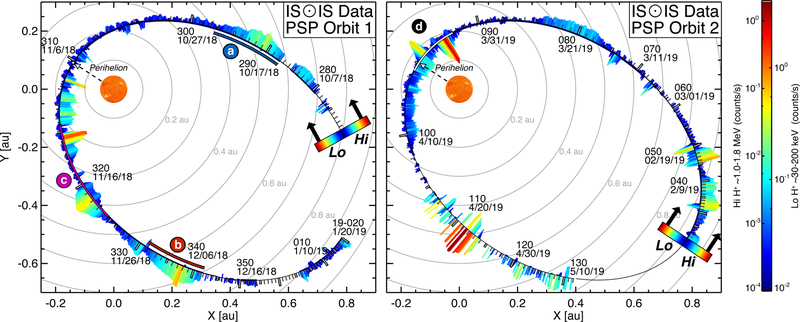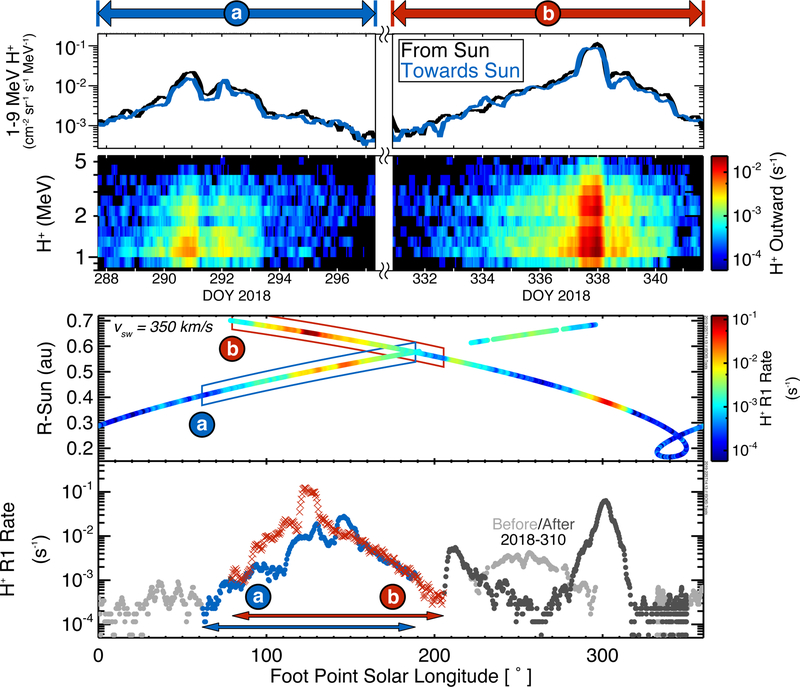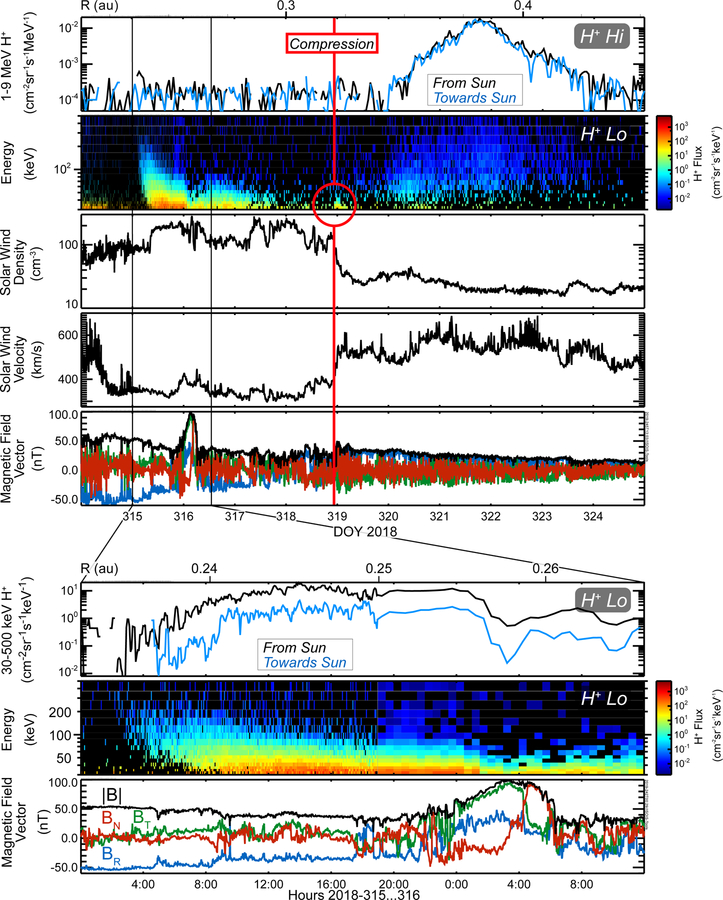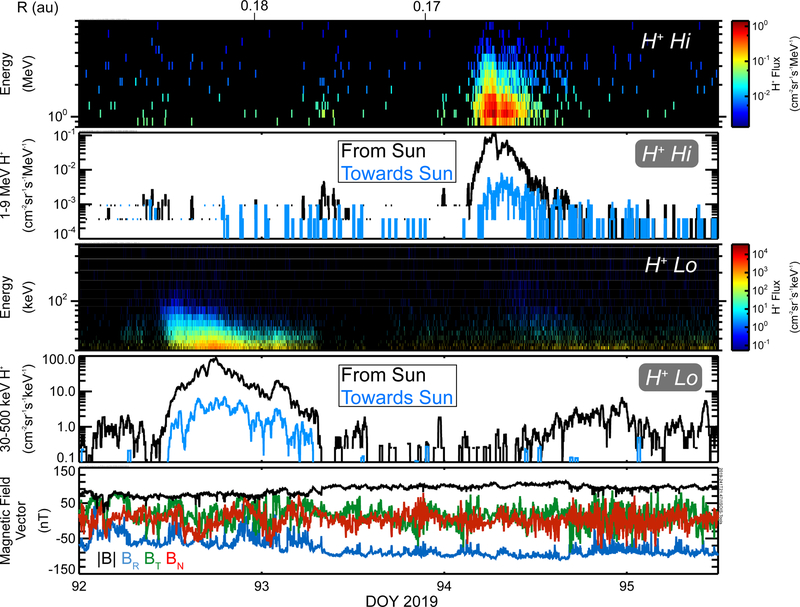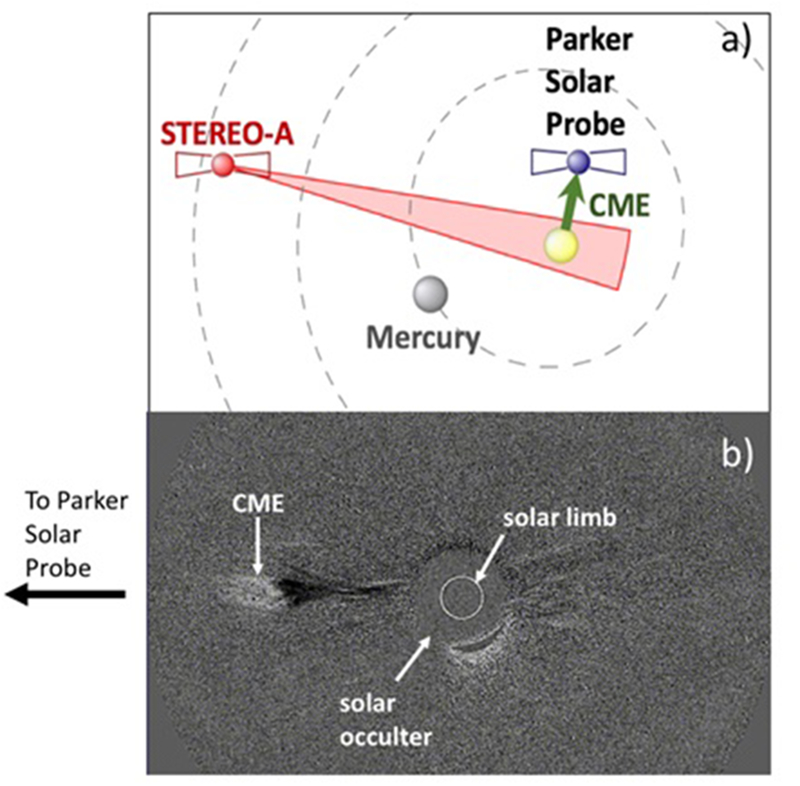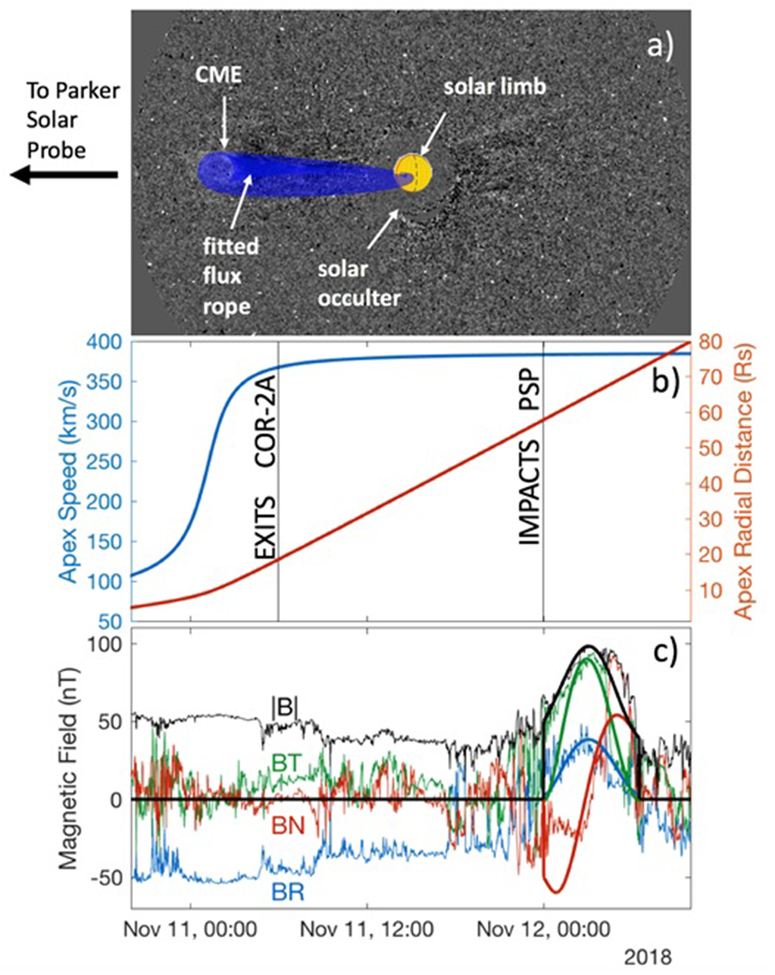NASA’s Parker Solar Probe mission1 recently plunged through the inner heliosphere to perihelia at ~24 million km, much closer to the Sun than any prior human-made object. Prior studies further from the Sun indicate that solar energetic particles are accelerated from a few keV up to near-relativistic energies in at least two ways. First, magnetic reconnection associated with solar flares often produces smaller “impulsive” events typically enriched in electrons,3He, and heavier ions2. Second, large Coronal Mass Ejection-driven shocks and compressions moving through the corona and inner solar wind are associated with “gradual” events3,4 that predominantly generate 1–10 MeV protons. However, some events show aspects of both processes and there is no bimodal distribution of the electron/proton ratio as expected for this simple picture5. Here we report the first observations of the near-Sun energetic particle radiation environment over PSP’s first two orbits. We find a great variety of different types of energetic particle events accelerated both locally and remotely, including by corotating interaction regions, impulsive events driven by acceleration near the Sun, and an event related to a Coronal Mass Ejection. These observations – so close to the Sun – provide critical information for investigating the near-Sun energization and transport of solar energetic particles. These processes were difficult, if not impossible, to resolve from prior observations owing to processing of energetic particle populations en route to more distant observing spacecraft6. Here we directly explore the physics of particle acceleration and transport in the context of various theories and models that have been developed over the past decades. Thus, this study marks a major milestone with humanity’s reconnaissance of the near-Sun environment and provides the first direct observations of the energetic particle radiation environment in the region just above the corona.
Onboard Parker Solar Probe (PSP), the Integrated Science Investigation of the Sun (ISʘIS) instrument suite7 made groundbreaking measurements of solar energetic particles (SEPs). ISʘIS comprises two Energetic Particle Instruments measuring higher (EPI-Hi or Hi) and lower (EPI-Lo or Lo) energy particles, with overlapping coverage7. Together this enables ISʘIS to explore the near-Sun environment by measuring fluxes, energy spectra, anisotropy, and composition of suprathermal and energetic ions from ~0.02–200 MeV/nucleon (nuc) and electrons from ~0.05–6 MeV. Here, we examine this energetic particle environment in the context of in situ solar wind8 and magnetic field9 conditions and surrounding density structures10 measured by other instruments aboard PSP.
Fig. 1 summarizes ISʘIS observations of energetic particles over PSP’s first two orbits. Higher (1–2 MeV) and lower (30–200 keV) energy H+ ion counts are plotted on the outside and inside of the orbital trajectory, respectively. Intensifications indicate energetic particle events, with some seen only at higher energies, some only at lower energies, and others simultaneously at both. Fig. 1 indicates how rich the ISʘIS observations are, with a broad array of different types of particle events at all distances.
Fig. 1:
Orbit 1 and 2 Energetic Particle Summary Plot
Summary of observations of energetic particles (primarily H+) at lower energy (Lo: ~30–200 keV, inside orbital track) and higher energy (Hi: ~1–2 MeV, outside orbital track) from PSP’s first two orbits; intervals without data are indicated by the grey orbital track. Particle intensity is indicated by both color and length of the bars. We identify Intervals a–d for detailed study.
The first large intensification occurred at higher energies with PSP inbound in Orbit 1 (Interval a, 2018–287 18:00 to 2018–297 08:20 UT) at ~0.5 au. While not obvious from Fig. 1, this is a corotational event also seen when PSP was outbound at ~0.65 au (Interval b, 2018–330 23:20 to 2018–341 15:00 UT). Corotating Interaction Regions (CIRs) form as faster solar wind piles up behind slower wind, forming a compression11,12. Because these faster solar wind streams eminate from coronal holes at the Sun, CIRs map to nearly fixed solar longitudes.
Fig. 2 shows Intervals a and b as a function of solar surface “foot point” longitude, calculated for a nominal Parker Spiral with a fixed solar wind speed of 350 km s−1. This calculation combines the rotation of the Sun and spacecraft location to show that both events arise from the same, single CIR structure. These events are “dispersionless,” with all ions arriving at roughly the same time and fluctuations in intensity consistent across ion speeds. Such events indicate that PSP passed across magnetic flux tubes that were already filled with high-energy (>1 MeV) particles that move quickly along the field. Intensities of sunward and anti-sunward moving particles in Intervals a and b were similar (top panels), consistent with a corotating structure that traps particles between a source further out than the spacecraft and the increasing magnetic field strength closer to the Sun. The particle acceleration probably occurs at reverse shocks, which typically form beyond ~ 2 au from compressions in such CIRs.
Fig. 2:
Recurring Corotating Energetic Particle Events
Corotating ion event seen in Intervals a (blue) and b (red) versus time (top) and as a function of magnetic foot-point in Carrington longitude for a nominal 350 km s−1 solar wind speed (bottom panels).
The inbound leg toward perihelion 1 was extremely quiet from ~0.4 au, providing an ideal opportunity for other PSP instruments to observe very quiet solar wind conditions with essentially no SEP-produced penetrating backgrounds. ISʘIS began to observe lower energy SEPs starting just before and increasing after perihelion 1. Fig. 3 shows the events in Interval c, including low energy ions ahead of a CME, the passage of a compression wave after it, and a subsequent higher energy particle event.
Fig. 3:
CME-Related Low-Energy Event and Following High-Energy Event
Time series (top five panels) of primarily protons at >1 MeV and ~30–500 keV, density and radial speed13 and magnetic field vector and magnitude14 over Interval c. The bottom three panels expand the dispersive SEP event and CME.
ISʘIS observations show an SEP event starting early on 2018–315 and extending to about when the CME arrived at PSP on 2018–316. Particle anisotropies (third panel from bottom) demonstrate that these particles are streaming outward from the Sun. The faster particles arrive first, characteristic of a “dispersive SEP event,” (second panel from bottom) with the differing arrival times giving an estimate of the distance along the magnetic field back to their acceleration source. For the time/energy slope in Fig. 3, we estimate a path length3 longer than the Parker Spiral from PSP at ~0.25 au, which might be explained by a longer path length associated with magnetic field “switchbacks” observed by PSP in situ14.
Solar observations from the white light coronagraph on the “A” spacecraft of NASA’s Solar TErrestrial RElations Observatory (STEREO-A) indicate that the SEP-associated CME started lifting off from the Sun on 2018–314 at ~18 UT (Extended Data Fig. 1). Derivation of the CME speed from STEREO-A imaging (Extended Data Fig. 2) reveals that the CME was moving slowly (<400 km/s) from the Sun to PSP, very similar to the surrounding solar wind speed. By propagating this CME flux rope at a constant speed of 380 km s−1 from near the sun to PSP, we find good agreement with the in situ magnetic field observations. Preliminary analysis of this event using shock-modeling techniques15 suggests that there was likely no shock on field lines well connected to PSP. However, a quasi-perpendicular sub-critical shock (Mach number <3) could have formed over an extended region of the flux rope and perhaps accelerated the protons measured by PSP (A. Kouloumvakos, private communication). This energetic particle event was not seen at any of the 1 au spacecraft, so such small events may only be observable close to the Sun and therefore much more common than previously thought.
At the end of 2018–318, the solar wind speed increased from ~300 to ~500 km s−1 [13], indicative of a strong dynamic pressure wave in the solar wind. ISʘIS observes a small enhancement in very low energy particles (<50 keV) as this compressional wave passes. This event is the first direct observation of local energization in the ISʘIS observations. Shocks are not required for particle acceleration16 and plasma compressions can accelerate particles provided the particles are able to propagate across, but remain close to the compression17.
The large, two-step increase in speed shows that this wave is well on its way to steepening into a forward/reverse shock pair, which most likely accelerates the higher (>1 MeV) energy particles observed from 2018–320 to 2018–324. This is not a CIR as in Intervals a and b, as it has a much narrower range of foot point longitudes (see enhancement at ~300° in Figure 2) and does not recur, but instead indicates the interaction of a single fast solar wind stream, possibly associated with or even magnetically opened by the preceding CME. In any case, as with CIR-associated particle events, the particle isotropy indicates that these ions are trapped on flux tubes, likely with a source beyond PSP. In fact, while the second event was seen ~1–6 days after the passage of the compression at PSP, the pressure front had expanded outward to heliocentric distances of ~0.6–2 au, where it likely formed the shocks.
Very near perihelion (~35 Solar Radii, Rʘ) on PSP Orbit 2 (Interval d), ISʘIS observed a unique pair of SEP events (Fig. 4). As PSP is nearly co-rotational with the Sun near perihelion, the two events are magnetically connected to a common solar source <5° apart in longitude. First, on 2019–092 there was a low-energy dispersive event, probably associated with an impulsive source in the low corona. Two days later, on 2019–094, there was a quite different type of impulsive event, marked by a substantial enhancement of >1 MeV ions. Both events exhibit strong, persistent magnetic-field-aligned ions streaming away from the Sun.
Fig. 4:
Pair of Impulsive Events Near Second Perihelion
Two impulsive SEP events (Interval d) near PSP’s second perihelion (<40 Rʘ) at higher energies (top two panels) and lower energies (third and fourth panels), compared to the magnetic field (bottom).
The first event, starting on 2019–092, may be associated with disturbances in EUV images from STEREO-A in the vicinity of active region AR2738, as well as multiple type-III radio bursts by both STEREO-A and PSP/FIELDS14. This small active region was ~70° off the nominal magnetic connection of PSP to the Sun. The fluxes of high-energy protons are near background, but we observed a statistically significant number of heavy, high-energy, ions and at low energies (~30 keV/nuc). He/H is ~20 times higher than the event on 2019–094, and the O and Fe abundances are even more enhanced. These results suggest that this may be a “Z-rich” event18; such events are relatively rare at 1 AU.
The second SEP event, on 2019–094 also exhibits velocity dispersion and outward streaming, but has many fewer ions <1 MeV and a significant increase at >1 MeV. As with 2019–092, there is potentially related radio and EUV activity in AR2738. However, the heavy ion abundances were similar to more typical solar energetic particle events. The magnetic field observed at PSP (bottom panel) between the two events was stronger and significantly smoother than before or after, indicating that this was likely a single, lower β (particle pressure/magnetic pressure) magnetic structure connecting the two events. Further, these observations indicate that processes inside 0.17 AU, as suggested by early multi-spacecraft studies in Solar Cycle 20, as well as later Helios and STEREO studies19,20,21,22, enable fast, direct access of SEPs to a wide range of solar longitudes. Later studies that combined in-situ data with solar source region observations showed that the smaller, longitudinally distributed SEP events are associated with multiple jet-like coronal emissions23,24 close to the source region as well as with more spatially extended eruptions25.
ISʘIS observed a surprisingly rich array of energetic particle phenomena during PSP’s first two orbits. Several of these events were not observed by 1 au spacecraft, so small events, only observable close to the Sun, may be much more common than previously thought. With these new data, we are well on the way to resolving the fundamental questions of the origin, acceleration, and transport of SEPs into the heliosphere. Over the next five years, as we head toward solar maximum, PSP will orbit progressively closer to the Sun, ultimately extending our exploration of these critical processes down to inside 10 Rʘ.
Extended Data
Extended Data Fig. 1:
Viewing Geometry and Observation of Coronal Mass Ejection
Panel a: a view of the ecliptic plane from solar north at 14UT on 10 November 2018 showing the relative positions of STEREO-A, Parker Solar Probe and dashed curves represent the orbits of Mercury, Venus, and Earth. The field of view of the COR-2 instrument onboard STEREO-A is shown as the red area. A CME off the East limb of the Sun as viewed from STEREO-A would be roughly propagating towards Parker Solar Probe. This CME entered very gradually the field of view of COR-2, part of the SECCHI suite of imaging instruments26 aboard the Solar-Terrestrial Relations Observatory (STEREO) spacecraft. Panel b: A running-difference image of the Coronal Mass Ejection taken at 02:39UT on 11 November 2018 by COR-2A, extending in the plane of the sky from 2 to 15 solar radii, provided images during the entire acceleration phase of the CME. This CME entered COR-2A near 18UT on 10 November 2018 and transited through the COR-2 field of view over ~12 hours.
Extended Data Fig. 2:
Coronal Mass Ejection Model and Comparison to Magnetic Field Data
Panel a: the same as Fig. 1b but with superposed fitted-flux rope CME shape at 02:39UT on 11 November 2018 when the CME had passed half way through the COR-2A field of view. The CME is very weak and no shock-sheath structure can be identified in these images. The typical aspect of the CME in the image results from the line of sight integration of plasma distribution on a bent toroid such that its major axis is located in a plane containing the observing spacecraft (see very similar events in Thernisien et al. 200927, Rouillard et al. 200928). Panel b: The position (red line) and speed (blue line) of the apex of the flux rope model was derived by comparing iteratively each synthetic image produced by the 3-D model with each available COR-2A image. A functional form (arctangent) was imposed for the flux rope’s varying speed. The fitted CME structure assumed in the present work is a bent toroid with an exponential increase of its cross-sectional area from footpoint to apex as in Wood et al. (2009)29. Panel b: The speed was derived by fitting a hyperbolic tangent to the modeled CME position. The speed increases rapidly from under 100 km/s at 18UT on 10 November to over 350 km/s when it exited the COR-2A field of view at around 6UT on 11 November. Panel c: An internal magnetic field structure was expressed analytically inside the envelope of the fitted CME (smooth curves) as in Isavnin (2016),30 but keeping here a simple circular cross section of the flux rope. By propagating this flux rope at a constant speed of 380 km/s from the time it exits the COR-2 to Parker Solar Probe, we predict an impact of the CME at PSP on 12 November 2018. The predicted arrival time and the magnetic properties of the CME (thick smooth line) are in good agreement with those measured in situ by the FIELDS (magnetic field data shown; thin lines) and SWEAP instruments. We therefore conclude that the fitting procedure presented here provides a good description of the CME evolution from the upper corona to PSP.
Acknowledgements.
We are deeply indebted to everyone that helped make the PSP mission possible. In particular, we thank all of the outstanding scientists, engineers, technicians, and administrative support people across all of the ISʘIS institutions that produced and supported the ISʘIS instrument suite and support its operations and the scientific analysis of its data. This work was supported as a part of the PSP mission under contract NNN06AA01C. SDB acknowledges the support of the Leverhulme Trust Visiting Professorship program and APR acknowledges financial support from the ANR project COROSHOCK ANR-17-CE31-0006-01 and from the ERC project SLOW_SOURCE - DLV-819189.
Footnotes
The authors declare no competing financial interests.
Readers are welcome to comment on the online version of the paper.
Publisher’s note: Springer Nature remains neutral with regard to jurisdictional claims in published maps and institutional affiliations.
Data Availability
The PSP Science Data Management Plan, requires that all science data from the first two orbits must be delivered to NASA’s Space Physics Data Facility (SPDF) within six months of downlink. Thus, all data used in this study will be delivered to the SPDF no later than 12 November 2019 for public release.
References and Notes
- 1.Fox NJ et al. The Solar Probe Plus mission: Humanity’s first visit to our star. Space Science Reviews 204, 7–48 (2016). [Google Scholar]
- 2.Mason GM 3He-Rich Solar Energetic Particle Events. Space Science Reviews 130, 231–242 (2007). [Google Scholar]
- 3.Desai MI & Giacalone J Large gradual solar energetic particle events. Living Reviews in Solar Physics 13, (2016). [DOI] [PMC free article] [PubMed] [Google Scholar]
- 4.Reames DV Solar Energetic Particles: A Modern Primer on Understanding Sources. Acceleration and Propagation, Lecture Notes in Physics 932 (Springer International Publishing AG, 2017). [Google Scholar]
- 5.Cane HV, Richardson IG & von Rosenvinge TT A study of solar energetic particle events of 1997–2006: Their composition and associations. Journal of Geophysical Research: Space Physics 115, (2010). [Google Scholar]
- 6.Wibberenz G & Cane HV Multi-Spacecraft Observations of Solar Flare Particles in the Inner Heliosphere. The Astrophysical Journal 650, 1199–1207 (2006). [Google Scholar]
- 7.McComas DJ et al. Integrated Science Investigation of the Sun (ISIS): Design of the energetic particle investigation. Space Science Reviews 204, 187–256 (2016). [Google Scholar]
- 8.Kasper JC et al. Solar Wind Electrons Alphas and Protons (SWEAP) Investigation: Design of the Solar Wind and Coronal Plasma Instrument Suite for Solar Probe Plus. Space Science Reviews 204, 131–186 (2016). [Google Scholar]
- 9.Bale SD et al. The FIELDS Instrument Suite for Solar Probe Plus. Measuring the Coronal Plasma and Magnetic Field, Plasma Waves and Turbulence, and Radio Signatures of Solar Transients. Space Science Reviews 204, 49–82 (2016). [DOI] [PMC free article] [PubMed] [Google Scholar]
- 10.Vourlidas A et al. The Wide-Field Imager for Solar Probe Plus (WISPR). Space Science Reviews 204, 83–130 (2016). [DOI] [PMC free article] [PubMed] [Google Scholar]
- 11.Pizzo V A three-dimensional model of corotating streams in the solar wind, 1. Theoretical foundations. Journal of Geophysical Research 83, 5563 (1978). [Google Scholar]
- 12.Gosling J Corotating and Transient Solar Wind Flows in Three Dimensions. Annual Review of Astronomy and Astrophysics 34, 35–73 (1996). [Google Scholar]
- 13.Kasper JC et al. Nature, (2019). [Google Scholar]
- 14.Bale SD et al. Nature, (2019). [Google Scholar]
- 15.Kouloumvakos A et al. Connecting the Properties of Coronal Shock Waves with Those of Solar Energetic Particles. The Astrophysical Journal 876, 80 (2019). [Google Scholar]
- 16.Chotoo K et al. The suprathermal seed population for corotating interaction region ions at 1 AU deduced from composition and spectra of H+, He++, and He+ observed on Wind. Journal of Geophysical Research: Space Physics 105, 23107–23122 (2000). [Google Scholar]
- 17.Giacalone J, Jokipii JR & Kota J Particle Acceleration in Solar Wind Compression Regions. The Astrophysical Journal 573, 845–850 (2002). [Google Scholar]
- 18.Zwickl RD, Roelof EC, Gold RE, Krimigis SM & Armstrong TP Z-rich solar particle event characteristics 1972–1976. The Astrophysical Journal 225, 281 (1978). [Google Scholar]
- 19.Reinhard R & Wibberenz G Propagation of Flare Protons in the Solar Atmosphere. Solar Physics 36, 473–494 (1974). [Google Scholar]
- 20.Kallenrode MB Particle propagation in the inner heliosphere. Journal of Geophysical Research: Space Physics 98, 19037–19047 (1993). [Google Scholar]
- 21.Richardson IG, von Rosenvinge TT & Cane HV The Properties of Solar Energetic Particle Event-Associated Coronal Mass Ejections Reported in Different CME Catalogs. Solar Physics 290, 1741–1759 (2015). [Google Scholar]
- 22.Widenbeck ME, et al. , The Astrophysical Journal, Volume 762, Issue 1, article id. 54, 9 pp. (2013). [Google Scholar]
- 23.Bucik R, et al. ApJL 869, L21 (2018), doi: 10.3847/2041-8213/aaf37f [DOI] [Google Scholar]
- 24.Bucik R, et al. , The Astrophysical Journal, May 2014, Volume 786, Issue 1, article id. 71, 12 pp doi: 10.1088/0004-637X/786/1/71 [DOI] [Google Scholar]
- 25.Nitta N, et al. , The Astrophysical Journal, Volume 806, Issue 2, article id. 235, 12 pp. (2015). [Google Scholar]
- 26.Howard RA, Sun earth connection coronal and heliospheric investigation (SECCHI), Advances in Space Research, 29, 12 (2002). [Google Scholar]
- 27.Thernisien A, Vourlidas A & Howard R Forward Modeling of Coronal Mass Ejections Using STEREO/SECCHI Data. Solar Physics 256, 111 (2009). [Google Scholar]
- 28.Rouillard AP et al. A solar storm observed from the Sun to Venus using the STEREO, Venus Express, and MESSENGER spacecraft. Journal of Geophysical Research 114, (2010). [Google Scholar]
- 29.Wood B & Howard R An empirical reconstruction of the 2008 April 26 coronal mass ejection. The Astrophysical Journal 702, 901–910 (2009). [Google Scholar]
- 30.Isavnin A FRiED: a novel three-dimensional model of coronal mass ejections. The Astrophysical Journal 833, 2, 10 (2016). [Google Scholar]



